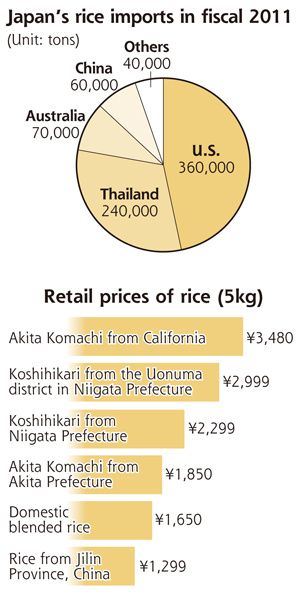
information about Fukushima published in English in Japanese media info publiée en anglais dans la presse japonaise
6 Avril 2012
April 6, 2012
![]() http://www.yomiuri.co.jp/dy/business/T120405005578.htm
http://www.yomiuri.co.jp/dy/business/T120405005578.htm
![]()

As domestic rice prices increased following the crisis at the Fukushima No. 1 nuclear power plant, an increasing number of consumers are opting for cheaper imported rice.
Some restaurant operators started using imported rice on their menus in an apparent move to gauge customers' reactions with an eye on the Trans-Pacific Partnership trade negotiations, which Japan has expressed an intention to join.
Seiyu GK, a major supermarket chain operator in Kita Ward, Tokyo, started selling rice from China's Jilin Province on March 10 at its 149 stores in Tokyo and five other prefectures in the Kanto region, as well as Shizuoka Prefecture.
At Seiyu's Akabane store in the ward on Wednesday afternoon, a 45-year-old homemaker said she had tried the Chinese-grown rice once, which sells for 1,299 yen for five kilograms.
"We have no complaints about the taste," she said. "We appreciate the affordability as we have a son in middle school who has a big appetite."
The Jilin rice is increasingly popular as it is about 20 percent cheaper than the most affordable domestic product--a blended rice priced at 1,650 yen, according to a Seiyu public relations official.
"It's been selling much better than we expected," he said.
The hospitality industry is also seeing an increasing number of restaurant operators using imported rice.
Kappa Create Co., an operator of a sushi restaurant chain in Saitama, for example, has been using U.S. rice at a restaurant in the city since January.
Matsuya Foods Co. in Musashino, Tokyo, which runs gyudon beef bowl restaurants, followed suit in February by mixing domestic and Australian rice at about 70 percent of its eateries.
The chain operator prefers harder rice because it soaks up less sauce than regular rice does. However, the company was unable to secure enough hard domestic rice this year.
"We realized that [gyudon] tastes better with harder Australian rice than with soft domestic rice," a Matsuya official said.
Many restaurant operators are willing to use imported rice due to shortages of affordable domestic rice.
The average trading price of rice was 15,327 yen per 60 kilograms in February--up 21 percent from a year before--according to the Agriculture, Forestry and Fisheries Ministry.
"Many farmers are unwilling to sell rice, expecting prices to rise," an official from a major rice wholesaler said of a possible factor behind the price increase.
The number of restaurant operators interested in using imported rice is believed to be rising dramatically, according to Toshikazu Nishira, 50, who runs a rice shop in Sanda, Hyogo Prefecture.
"We receive online orders for cheap Chinese rice from those we presume are in the hospitality industry," he said.
In July last year, a law concerning rice origins came into full effect. The law obliges restaurant operators to keep records on rice purchases and label the place of origin, making it easy for consumers and others to see where foreign rice is served.
===
Limited amount of imports
No matter how popular foreign rice becomes, however, only a limited amount can be imported.
The country currently imposes a 778 percent tariff on foreign rice to protect domestic farmers. Therefore, only 100 to 200 tons of rice is imported by paying the tariff each year.
Foreign rice currently available in the market has been imported through the so-called minimum access system.
Under the Uruguay Round in the General Agreement on Trade and Tariffs in 1993, Japan is required to import a specific amount of rice every year tariff-free. It currently imports about 770,000 tons of rice every year under the system, while about 8 million tons of rice is harvested domestically.
Most of the minimum access rice is used as animal feed or as an ingredient in processed food, with some sent as aid to foreign countries.
Under the minimum access system, a maximum of 100,000 tons of rice can be imported as staple food. Calls may come, however, to expand the amount if imported rice becomes more popular, experts said.
(Apr. 6, 2012)